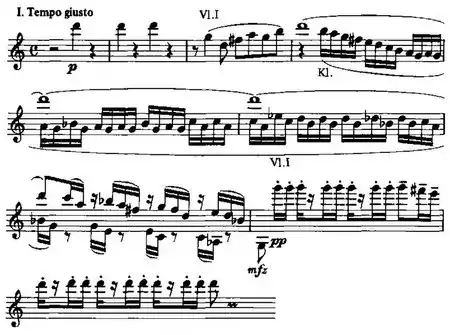Symphony No. 6 "Sinfonia semplice", (no opus number), FS 116. In August 1924 Danish composer Carl Nielsen began working on a Sixth Symphony, which turned out to be his last. By the end of October he wrote to Carl Johan Michaelsen:
As far as I can see, it will on the whole be different from my other symphonies: more amiable and smooth, or how shall I put it, but it is impossible to tell as I do not know at all what currents I may run into during the voyage.[1]
The first movement was finished at the end of November while he was in Copenhagen, and the second movement was composed during Christmas. At the end of January 1925 he traveled to the French Riviera with his wife.
While he had been in Copenhagen, Nielsen had composed the third movement, but he now had to put the symphony aside to work on a commission for incidental music to Ebbe Skammelsen, which was to be performed at the Open Air Theatre in the deer park. He completed the Ebbe Skammelsen score immediately before his sixtieth birthday on June 9. While traveling to Damgaard[lower-alpha 1] in the middle of July 1925, Nielsen was able to continue work on his symphony.[1]
The last movement was finally completed on December 5, 1925. The first performance was given by the Chapel Royal Orchestra on December 11. The Copenhagen reviewers were confused by the style of the new Symphony. Nielsen had called it "Sinfonia semplice" (Simple Symphony). It has remained the least performed of all six symphonies.[1]
Instrumentation
Description
There are four movements:
- Tempo giusto
- Humoreske: Allegretto
- Proposta seria: Adagio
- Tema con variazioni: Allegro
According to Robert Simpson, from the second edition of his book on Nielsen, this work may be partially autobiographical; the composer had just experienced a tremendous success with his Fifth symphony, but had also suffered a series of heart attacks.[2] He was to write several more works, but in the remaining six years of his life, the atmosphere of his works began to change.
As with many other works by Nielsen starting as early as his first symphony, this symphony uses "progressive tonality", not only starting in one key (G major), and ending in another (B-flat), but making the change part of the drama of the work.
First movement
The chiming of a glockenspiel opens the symphony, followed by a melody in octaves played by the violins. This is followed in turn by active and very characteristic figures in the winds.

As in the fifth symphony there is an early hint of the key B-flat in which the symphony will eventually close, since the wind response hits that B-flat as an on-and-off note in an otherwise G major passage. The mood of the opening gives way to fugal unrest and, eventually, two chaotic and disturbing outbursts (Simpson believes these reflect Nielsen's heart attacks, in a manner of speaking, though he does not claim that the piece is programmatic), before again quieting, to a lightly scored but unsettled close in A-flat.
Second movement
The Humoreske is for winds and percussion alone. In the notes Nielsen wrote for the symphony's premiere, he said that wind and percussion in the movement "quarrel, each sticking to his own tastes and inclinations";[3] Nielsen went on to liken this to the musical world of the time.

Third movement
Proposta seria. To paraphrase Simpson, again, several passages in this movement circle around as though snakes chasing for-the-moment lost tails.

Finale
Fanfare, theme and variations, fanfare-reprise and coda, on a fairly unstable theme in B-flat. The ninth variation, just before the fanfare-reprise and coda, has a sound and affect like that of the Humoreske — Simpson likens it to a grinning skeleton; as in many sets of variations, it is preceded by a minor key variation (a variation in the parallel minor), but one that is so protracted that when its last minor cadence arrives it is difficult to grasp as one whole variation. The critic Robert Layton has described this as a lament.

The last note of the piece is a sustained low B-flat played loudly on two bassoons.
Notes
- ↑ Fanning 1997, p. 97: Damgaard was the home of Nielsen's friend Charlotte Trap de Tygeson in Jutland.
References
- 1 2 3 Carl Nielsen.dk - Art and Consciousness
- ↑ Simpson 1979, p. 115
- ↑ Simpson 1979, p. 113 quotes extracts from a newspaper interview given by Nielsen
Sources
Books
- Fanning, David (1997). Nielsen: Symphony No. 5. Cambridge University Press. ISBN 978-0-521-44088-2.
- Simpson, Robert (1952). Carl Nielsen, Symphonist (1st ed.). London: J. M. Dent. ASIN B0000CIDKO. See pages 105–123. Reprinted by Hyperion Press ISBN 978-0-88355-715-0.
- Simpson, Robert (1979). Carl Nielsen, Symphonist, 1865–1931 (2nd ed.). London: Kahn & Averill. ISBN 978-0-900707-46-9. See pages 112–136.
Scores
- Michelsen, Thomas, ed. (2001). Symphony No. 6 (PDF). II. Instrumental Music. Vol. 6. The Carl Nielsen Edition, Royal Danish Library. ISBN 978-87-598-1027-9. ISMN 979-0-66134-017-1. Archived (PDF) from the original on 16 October 2014.
{{cite book}}:|work=ignored (help) - Symphony No. 6 (Nielsen): Scores at the International Music Score Library Project